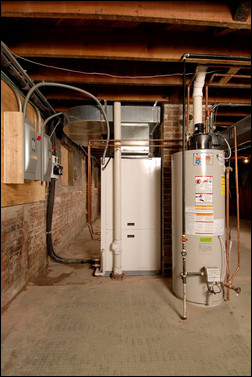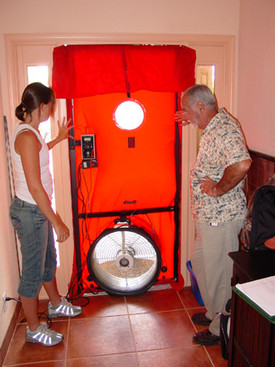Congress has allowed numerous federal incentives to make existing homes more energy efficient to expire. As of Dec. 31, 2007, federal residential tax credits for windows, doors, roofs, insulation, HVAC and non-solar water heaters ended. The federal tax credit for solar water heaters and solar panels expires Dec. 31, 2008.
 A blower door test to check for air leakage in the home is performed at a bungalow in Chicago. (c) Historic Chicago Bungalow Association |
But those fortunate enough to live in some areas can find programs to help them seal air leaks, change to energy-efficient lighting, upgrade to Energy Star appliances, build right from the start and more. At local, regional and state levels, there are cash-back rewards, tax credits, advice and education to assist residents in reducing energy use. Here’s a look at a few of the programs.
Community Initiatives
Chicago has about 80,000 bungalows, well-crafted homes with a style unique to this Midwestern city. The historic homes are 1 ½-stories with hipped roofs, face brick on the front and Chicago common brick on the other three sides. Limestone decorative elements and quality wood windows, framing and interior trim enhance the well-constructed homes.
The nonprofit Historic Chicago Bungalow Association, with a membership of more than 9,000 households, seeks to preserve these distinct residences. One way is to make them more affordable to live in by making them more energy-efficient.
Teaming up with the city of Chicago, the nonprofit Illinois Clean Energy Community Foundation, and Peoples Gas and Commonwealth Edison, the HCBA offers up to $6,000 to members for energy-efficiency improvements. More than 2,000 bungalow owners have taken advantage of the incentives since they were first offered in 2001.
The first goal is to air seal and insulate the homes, says Annette Conti, HCBA executive director. “Most people think first about replacing windows, but we are spreading the word about where they are losing heat.” She says the main culprit is often all of the little gaps in the building envelope.
Conti says an HCBA Green Bungalow Blocks program has promoted energy savings on target blocks in 2002, 2006 and 2007 and provides special grants for energy-efficiency upgrades. More than 30 bungalows on those blocks have received an energy audit and recommendations for weatherization. After the bungalows were sealed and insulated, homeowners saw 30 percent to 50 percent savings in energy usage.
“It’s just amazing,” says Conti. “If you add up all of the leaks that can occur in a home—gaps around joist pockets in the basement and doors without weatherstripping are common problems in bungalows—it can be the same as having a three-foot by three-foot window open all winter.”
 A geothermal unit installed in a Chicago bungalow provides an efficient means to heat and cool the home. (c) Historic Chicago Bungalow Association |
In addition to the energy-savers grants and appliance vouchers for purchase of energy-efficient appliances, the HCBA sponsors bungalow improvement seminars throughout the year
Small City Efforts
Parkland, a community of about 21,000 in Broward County, Fla., took the first strides in a new energy efficiency program this year. Households and businesses now have even more reasons to go green with a reward program created by Vice Mayor Jared Moskowitz and implemented with the assistance of Environmental Resources Director Brian Archer.
According to Archer, residents can submit applications for cash-back rewards in 12 areas, including buying a hybrid car ($200), replacing incandescent light bulbs with compact fluorescents (up to $100 maximum payout), installing an ultra low-flow toilet ($150), replacing an air conditioner with a high-efficiency unit ($100) and duct system test and repair ($50). There is only one reward per incentive per household and specific criteria must be met.
With communities facing increasing financial restraints, Parkland plans to review its reward budget each year. Archer emphasized that the program does not involve any new taxes and that revenue other than property taxes is used.
The program has had good reactions with many people calling about to get more information, says Archer. “A lot of people are planning ahead, perhaps to change out their air conditioning unit or get a hybrid car.” Seven people had already submitted reward applications by mid-July for changing out their air conditioning units.
Large City Initiative
San Francisco continues to build on its reputation as a progressive city with its latest environmental initiative. On July 1, it introduced GoSolarSF, a 10-year, $3.5 million-a-year program that proposes to see thousands of city residents and businesses put solar panels on their rooftops.
The program will pay residents $3,000 to $6,000 toward the purchase of the systems. Low-income residents can qualify for extra funds. Adding the city incentive to the California Solar Initiative, a state rebate program, and federal tax credits could cut the cost of each project to half ($11,000 to $15,000) of what a typical household solar setup might be.
The initiative was the product of a solar energy task force, says Tony Winnicker, a spokesperson for the San Francisco Public Utilities Commission. The task force looked at how to increase solar energy in this city which has abundant sunlight but less than 1,000 rooftops with solar panels. When research discovered that installation in the city was more expensive than in surrounding counties, it was decided to offer a program to help pay for the desired change.
 San Francisco has launched a program to encourage San Francisco residents to install solar panels on their rooftops. (c) San Francisco Public Utilities Commission |
Funding was a subject of much discussion and debate, according to Winnicker. The project budget finally came from a power enterprise fund set aside from operating revenue to incorporate solar energy at municipal buildings. It was decided that other financing could be obtained for the larger municipal projects.
“We’ve had hundreds of inquiries,” says Winnicker. Homeowners don’t get the money until the project is installed. An extensive outreach and marketing campaign is underway with information fairs and workshops scheduled. To maximize program benefits, the city provides added incentive money to the homeowner if a local installer is used and to the local installers if they employ at-risk youths.
The program is part of an array of green initiatives in the city including rebates for high-efficiency toilets and washing machines, free water-saving showerhead aerators and free water use evaluations.
 |
||||
|
||||
Combined Efforts
Residents of Oregon find initiatives on several levels to encourage them to make qualifying energy-efficient home improvements.
A residential energy tax credit allows dollar-for-dollar deductions against taxes owed on Oregon income tax filings. Any unused portion can be carried forward up to five years. For example, residents can get a maximum of $1,000 in tax credits for qualifying appliances, heating and cooling equipment and services installed per residence per year; $1,500 for qualifying photovoltaic systems per residence per year; $1,500 for qualifying renewable resource installations per residence per year and $1,500 for qualifying hybrid and alternative fuel vehicles per vehicle.
Households that heat with oil, propane, kerosene, butane or wood are eligible for weatherization incentives through the state’s Department of Energy State Home Oil Weatherization program.
Energy Trust of Oregon, Inc. is an independent nonprofit organization that helps state residents lower their energy use. It operates with revenues from a special fund. The fund was created from an annual 3 percent public purpose fee on bills of Oregon’s largest investor-owned electric utilities, and by a 1.5 percent public purpose charge on two of the state’s largest natural gas utilities.
Energy Trust offers various green programs, including incentives to purchase high-efficiency furnaces and heat pumps, water heaters, Energy Star clothes washers and refrigerators, solar electric and solar water heating, and small wind. There is the added benefit of free pickup of old refrigerators or freezers.
Its latest effort is in cooperation with the Oregon Department of Energy, Solar Oregon and City of Portland Office of Sustainable Development. Solar Now! provides cash incentives, tax credits and workshops for those interested in solar water heating, solar pool heating and photovoltaics, says Brooke Graham, residential marketing manager.
One of Energy Trust’s most popular offerings is a free home energy review, says Graham. The one-hour walk-through provides a visual assessment of needed efficiency upgrades. In addition, homeowners get up to 10 free compact fluorescents lights and a low-flow showerhead and aerator. Residents also can get a $150 discount coupon for a more extensive “Home Performance with Energy Star” program whole-house assessment.
As of March 2008, Energy Trust’s residential accomplishments included 19,000 home energy reviews conducted, 55,000 single-family homes retrofitted, 3,200 Energy Star new homes built, 3,200 new homes built with efficiency enhancements, 3,300 manufactured homes retrofitted, 840 efficient new manufactured homes purchased, 130,000 efficient clothes washers sold, 1.8 million CFL packages sold/distributed, 560 residential solar water heating installed, 550 residential solar electric systems installed and three small wind projects completed. It’s telling data, confirming the efficiencies that can be accomplished, with a little incentive.
Read other Green Homes Special Series articles here.
Credit: Renovate Your World




























